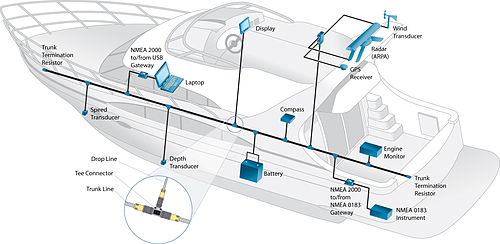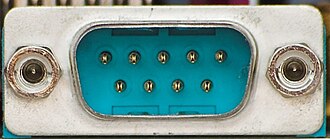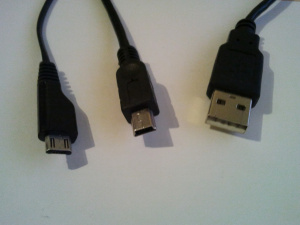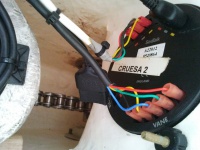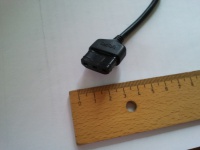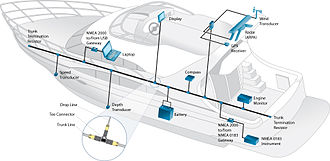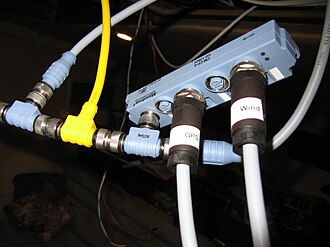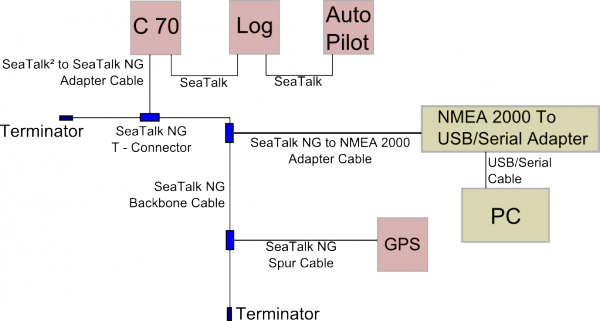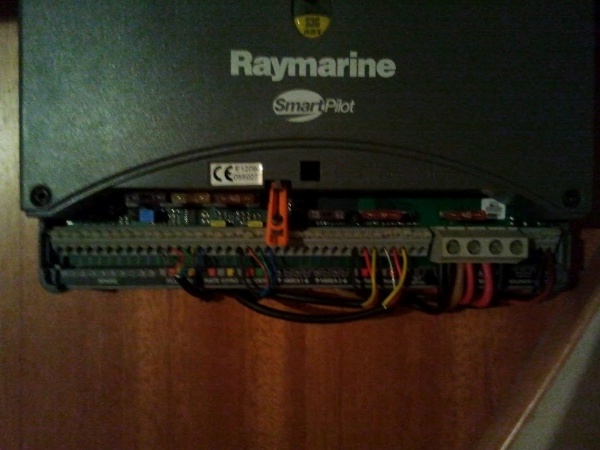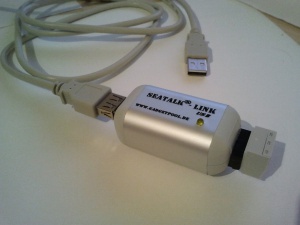h:En:Shipnetwork: Unterschied zwischen den Versionen
osm>Cleanerx (Die Seite wurde neu angelegt: „400px|right This page describes how to gather data of the ship's network with a computer. The short answer is: Eve…“) |
osm>Malcolmh |
||
| Zeile 1: | Zeile 1: | ||
[[Datei:NMEA2000 Modified motor yacht.jpg|400px|right]] | [[Datei:NMEA2000 Modified motor yacht.jpg|400px|right]] | ||
| − | This page describes how to | + | This page describes how to collect data from the ship's network with a computer. |
| − | + | Many manufacturers use their own proprietary connectors or protocols but most of them may be used with a standard connector and protocol. The following section describes how to attach certain devices in an efficient way. | |
An introduction to computer connectors and connectors from the ship's network is given first as they work in different ways. | An introduction to computer connectors and connectors from the ship's network is given first as they work in different ways. | ||
Version vom 21. September 2012, 21:14 Uhr
This page describes how to collect data from the ship's network with a computer.
Many manufacturers use their own proprietary connectors or protocols but most of them may be used with a standard connector and protocol. The following section describes how to attach certain devices in an efficient way. An introduction to computer connectors and connectors from the ship's network is given first as they work in different ways.
You may find a shortened manual here NMEA-Logger anschliessen (requires translation from german to english)
Inhaltsverzeichnis
Security Advice
The manufacturers of navigation devices spend much effort to protect their devices from dirt and water so that in case of a capsize or flooding devices have a chance to survive this. Computer connectors should be constructed in a way that a short circuit does not affect the ship's network. Good connector hardware offers galvanic isolation to cover this problem.
Laptop/Smartphone Connectors
Depending on the computer there are different connectors available. Some of them are wire bound, some of them are wireless.
Seriel Port
This port is known as RS-232 Port or COM Port.
Connector
The connector at the computer usually is a male 9-pole connector, so that a female connector on the cable side is required. Most state of the art computer no longer own such a connector, as their are to big. Computers built before 2008 probably own such a connector. Newer computer may use a USB to RS232 adapter that usually requires a driver for the operation system.
Transmission
Data is transferred byte wise which means every single byte must be actively processed as soon as it arrives on the opposite end.
USB (Universal Serial Bus)
This connector is the successor of the serial connector and reduces the amount of required space and the transmission rate.
Plug
Most laptops own a plug of typ A. Most Smartphones have Mirco USB plugs. Small devices often use Mini USB that sits in between micro and type A plugs in terms of size.
Transmission
The transmission of data from sensors is usually handled via a com port emulator that is installed into the operating system. This way old software may still use the com port and does not need to look after usb devices. Smartphones do not have such a device common access point which is why usb devices have to have a special driver for the smartphone operating system.
Bluetooth
This protocol uses a wireless connection which may be used to transfer serial data over short distances (ca. 10m) There are no connectors but the bluetooth logo indicates that a devices offers this kind of protocol. The protocol offers different transfer modes which may not be supported by every device. To use serial transfers the RFCOMM Profile is being used. An IPod does NOT offer this kind of protocol but most smartphone do offer this kind of protocol.
Ethernet/IP/TCP/UDP
Ethernet has become a synonym for network connection. Most of the data transfer in the internet passes over this kind of interface. It is a packet oriented protocol that transfers serveral bytes at once. Ethernet connections are currently not being used very often in marine equipment but some AIS devices have an ethernet connector.
WLAN (Wireless Local Area Network
Many smartphones and computers support this wireless network protocol. Technically it is based on ethernet and offers high bandwith with packet oriented data transfer. The wireless nature and the wide support of devices made it the choice for some manufacturers to equip latest devices with such an interface.
Manufacturer
The manufacturers advertise their products with standard conformance but most of them do NOT fully comply with them. There are many manufactur specific variants built into the protocol or connector system. The reasoning is an economic one: Manufacturers try to bind customers to their products by setting obstacles to switch to another system from another vendor. A technical reason for using almost-standard devices is of course the ever lasting process of standardization that may take years to complete. The customer has to suffer from this as he must buy expensive adaptor cables in order to connect the "standardized" devices.
Raymarine Protocols
Raymarine devices were built into many european ships mainly because major vendors like Bavaria had contracts with Raymarine.
SeaTalk 1
SeaTalk is a Raymarine developed serial protocol which is used by devices to exchange data. As the protocol itself is closed source two options are available:
- Buy an official SeaTalk to NMEA converter from Raymarine
- Buy a third party or homebrew device which reverse engeneered the protocol Brookhouse and GadgetPool offer such devices.
These gateways may be used to convert to NMEA 0183.
- SeaTalk Cabling
The SeaTalk cabling is done by attaching devices in a row. Every device should at least have to connectors. At the end of the bus a connector is free which may be used. Sometimes the bus end at the plotter which does have only one plug where the other end is attached to the battery. In that case no free connector is available and you need a Y-Cable in order to attach your device. The plug has three pins and is always female.
SeaTalk NG
SeaTalk NG (Next Generation, former: SeaTalk²) is based on NMEA-2000 bzw. CAN. The packet oriented protocol provides a bandwidth of 250 kbit/s. Data is being transferred as standardized NMEA-2000 / CAN Frames. Wiring is done through backbone cable which must be terminated by a resistor at each and. Devices are attached by adding T-connectors to the backbone. A connection to a PC may be established through a Raymarine converter. Alternatively you may buy an adapter cable which converts the backbone cable to a standard NMEA 2000 cable. There you may attach a NMEA-2000 to USB or Bluetooth or WLAN adapter device. Such a device is offered by Actisense (NGT-1). Note: You will a second NMEA-2000 to SeaTalk NG adapter cable with opposite pinout or a NMEA2000 terminator in order to terminate the bus correctly.
- SeaTalk NG Conector system
Raymarine developed a color coded plug system farbkodiertes Steckersystem for the bus system. Backbone cables, terminators, plugs and headers are coloured blue. Stingwires, plugs and headers are coloured white. SeaTalk-1 to SeaTalk-NG converter cable, plugs and headers are coloured yellow. SeaTalk-NG power cable are coloured red.
SeaTalk HS
SeaTalk HS (High Speed) is a Ethernet-based protokol. It is being used if the bandwidth of the CAN bus does not suffice. Usage examples are Raymarine displays connected to each other. Not much is known about this procotol except it is based on ethernet. No reverse engineering if this protocol is known or documented, yet. However it is likely that it is an IP based protocol stack.
Raymarine Devices
A-Series
C-Series (old)
A often used device is the C-70 which nowadays is being built as a new version. The installation manual may be found here Raymarine. On page 27 (PDF:33) you may find the available connectos. The described SeaTalk² protocol was renamed to SeaTalk-NG. The device therefore offers SeaTalk 1 and SeaTalk NG. You have three options to attach a computer:
- via SeaTalk 1: At the end of the bus add a SeaTalk 1 to NMEA 0183 converter
- integrate with the existing SeaTalk²/NG net and add a NMEA-2000 converter. Pay attention to correct wiring
- connect directly to NMEA-0183 daten connector (often used by the autopilot or something else).
Yacht manufacturers
- Bavaria used Raymarine devices up until 2011
- Beneteau uses Raymarine
- Jeanneau used Raymarine devices up until 2012
- ELAN uses Raymarine
E-Serie (alt)
E-Serie (neu)
G-Serie
E80
Furuno
Lowrance
Lowrance has a color coding of connector cables. The blue network was sold from 2005 to 2006. The red network has been sold since 2006. Using an adapter cable blue networks may be attached to red networks.
Garmin
NMEA-2000
Garmin uses the standard NMEA-2000 cables and connectors. Devices may be attached to a PC with a common NMEA-2000 to USB converter.
Standards
NMEA 0183
see NMEA-0183
NMEA 2000
see NMEA-2000
Bus Converter
| from | to | Manufacturer, Device | Notes | Price | Picture |
|---|---|---|---|---|---|
| SeaTalk | USB / NMEA-0183 | GadgetPool | Galvanic isolated, unshielded (not usuable without shielding) | 125 € | |
| SeaTalk, USB, NMEA-0183 and Bluetooth | Brookhouse | Connection Diagrams | |||
| SeaTalk | NMEA-0183 | Raymarine | |||
| NMEA-2000 | USB/Serial | Actisense | |||
| NMEA-0183 | WLAN | Digital Yacht | |||
